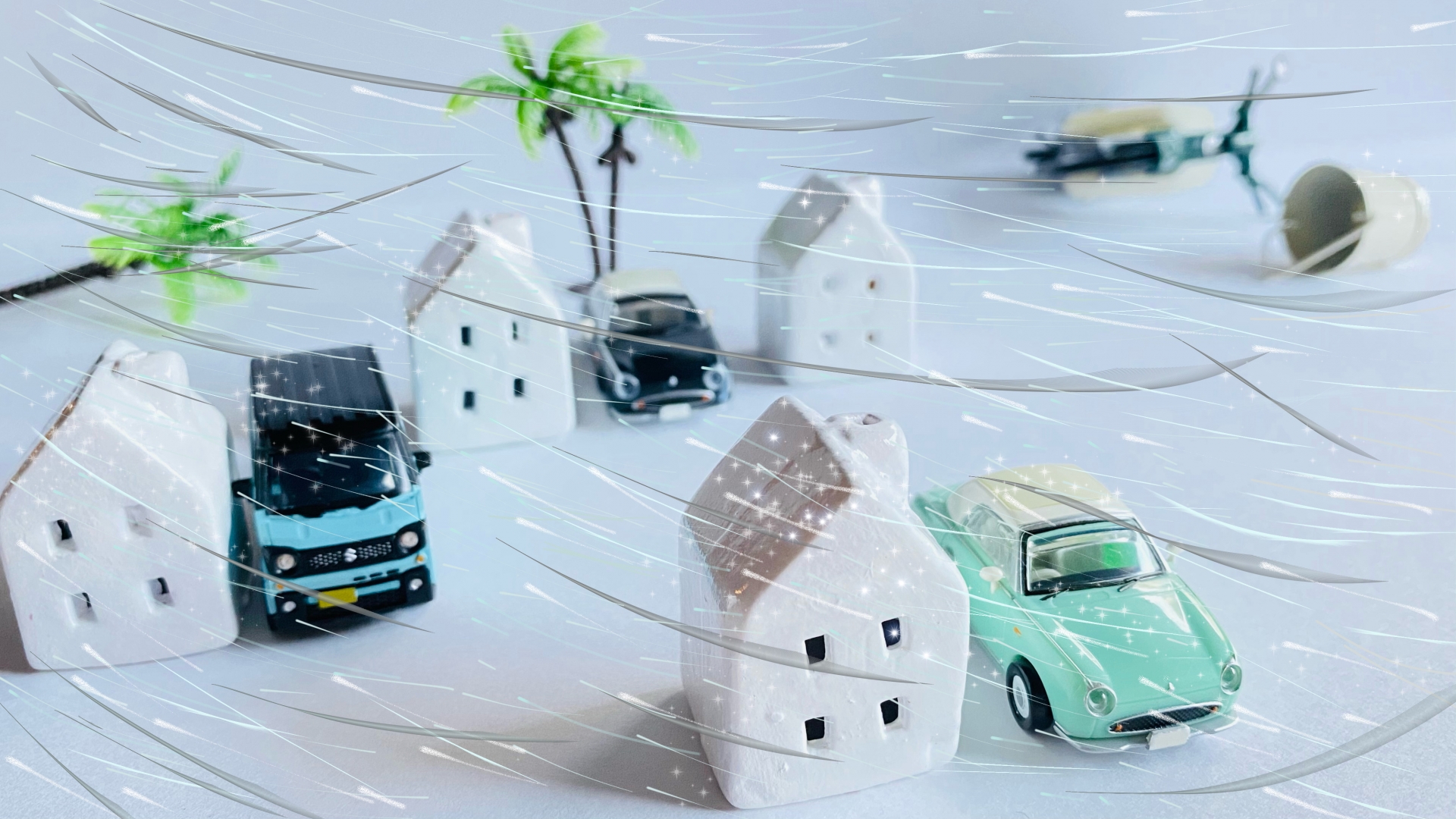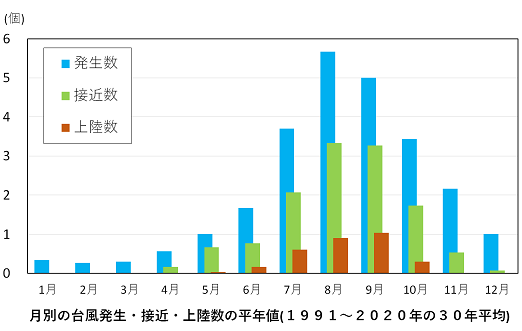Prepare for Japan's typhoon season! When typhoons are most frequent and how to prepare.
2024-09-27
Japanese Culture & Customs

Japan is a country where typhoon damage occurs almost every year.
Depending on the scale of the typhoon, there is a risk that properties may suffer significant damage from flooding or landslides.
However, the risk of typhoons varies depending on the time of year and region.
Therefore, if you own real estate or live in Japan, it is important to understand typhoons and take preventive measures.
In this article, we will explain Japan’s typhoon season and countermeasures in a clear manner.
Typhoon-prone periods in Japan
Typhoons are most common in Japan from July to October.
That said, it’s worth noting that typhoons can occur at any time of the year.
According to data from the Japan Meteorological Agency, an average of about 25 typhoons occur annually between 1991 and 2020.
The most typhoons occur in August, followed by September, July, and October. However, even in other months, 0.3 to 2.2 typhoons occur on average.
Although typhoons can occur throughout the year, the number of occurrences, as well as the number of approaches and landfalls, is highest between July and October.
According to the same data, out of the 25 typhoons that occur annually, the majority—13—occur between July and October.
Of the typhoons that occurred, 11.7 approached Japan, and of these, 10.4 approached between July and October, showing that most typhoons concentrate in this period.
While August sees the highest number of typhoons, typhoons in September tend to cause the most damage in Japan.
This is because typhoons in September tend to activate the autumn rain front, leading to heavy rainfall and more significant damage.
In fact, historically significant typhoons like the Muroto Typhoon and Ise Bay Typhoon occurred in September.

Reference: Japan Meteorological Agency, “Typhoon Occurrence, Approach, Landfall, and Paths
Expected damages caused by typhoons
Typhoons bring not only heavy rain, floods, strong winds, high waves, and storm surges, but they can also trigger river flooding, landslides, and mudslides, causing enormous damage.
For example, Typhoon No. 14 in September of Reiwa 4 (2022) crossed Japan with intense force, causing record heavy rains and strong winds, particularly in western Japan, including Kyushu.
In Miyazaki Prefecture, there were landslides and river flooding that led to loss of life, damage to homes, and damage to essential services and transportation infrastructure.
In recent years, the occurrence of linear rainbands with the approach of typhoons has led to extremely heavy rainfall in short periods, resulting in frequent flooding.
Additionally, it’s important to note that typhoon damage can occur not only along the direct path of the storm but also in distant locations.
Areas prone to significant damage
According to the Japan Meteorological Agency’s data on typhoon landfalls by prefecture between 1951 and Typhoon No. 17 in 2023, the rankings are as follows:
| Rank | Prefecture | Number of Landfalls |
|---|---|---|
| 1 | Kagoshima | 43 |
| 2 | Kochi | 26 |
| 3 | Wakayama | 25 |
| 4 | Shizuoka | 22 |
| 5 | Nagasaki | 18 |
| 6 | Miyazaki | 14 |
| 7 | Aichi | 12 |
| 8 | Chiba | 9 |
| 9 | Kumamoto | 8 |
| 10 | Tokushima | 7 |
Reference: Japan Meteorological Agency, “Number of Landfalls
It is clear that Kagoshima has experienced the highest number of landfalls.
Generally, summer typhoons are influenced by strong high-pressure systems and westerly winds, causing them to move westward after forming, and then turn northeast near Japan, passing through the country in a circular path from the south.
As a result, prefectures along the southwest coast, including Kagoshima, experience more typhoon landfalls.
However, it is important to note that areas that do not experience landfalls are not necessarily free from damage.
In regions where typhoons frequently land, such as Kagoshima, there are often measures in place to mitigate damage, such as storm-resistant housing.
Conversely, areas with fewer landfalls, like the capital region, may experience more severe damage when a typhoon does approach.
For example, Typhoon No. 19 (the Eastern Japan Typhoon) in October of Reiwa 1 (2019) made landfall on the Izu Peninsula and passed through the Kanto region. It caused widespread river flooding and landslides in the Kanto-Koshinetsu and Tohoku regions, resulting in significant loss of life and property damage.
Whether in areas with frequent landfalls or not, it is crucial to always prepare for typhoons.
How to prepare for typhoons
No matter where you are, it is essential to prepare for typhoons.
Here are three ways to prepare:
- Check hazard maps
- Take out fire insurance
- Take precautions before and after a typhoon
Checking hazard maps
When selecting a property, it is important to check hazard maps and choose properties in areas with lower disaster risks.
Hazard maps are issued by local governments and show the risks of various disasters, such as floods and earthquakes, by type.
By checking hazard maps, you can determine the types of disaster risks present in your desired area.
Taking out fire insurance
Damage from flooding due to typhoons or heavy rain can be covered by fire insurance.
It is important to take out fire insurance to ensure you are covered in case of emergency.
Insurance premiums vary greatly depending on the coverage. If you opt for lower premiums thinking, “It’s unlikely I’ll ever experience a fire,” you may not be covered for typhoon damage, so it is important to carefully review the coverage details before choosing a policy.
Note that fire insurance does not cover earthquake damage, so it is necessary to take out earthquake insurance separately.
Earthquake insurance must be purchased in combination with fire insurance, so consider adding it when you take out fire insurance. Since Japan is also prone to earthquakes, having earthquake insurance further reduces risk.
Precautions before and after a typhoon
Precautions you can take before a typhoon include the following:
- Apply protective tape or anti-shatter film to windows
- Clean gutters and drains to ensure proper water drainage
- Bring indoors any items that may fly away in strong winds
After a typhoon passes, carefully check the building for any abnormalities.
Generally, you will not be held responsible for damage caused by parts of your building being blown away during a typhoon, unless the damage was due to neglect, such as leaving broken parts unrepaired.
It is important to regularly inspect and properly maintain your property.
Conclusion
In this article, we have explained Japan’s typhoon season.
Typhoons increase in frequency and approach Japan more often between July and October. Areas along the southwestern coast of the Pacific Ocean experience more landfalls, so it is important to be well-prepared.
However, significant damage from typhoons can occur even in areas with fewer landfalls.
In any area, it is crucial to thoroughly prepare for typhoons.


